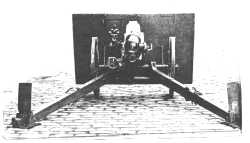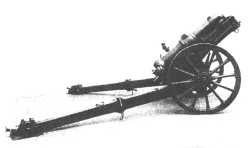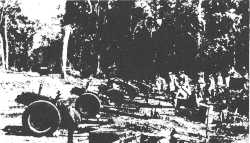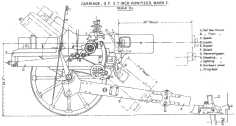|
| |||||||||||||||||||
QF 3.7-in Howitzer | |||||||||||||||||||
For nearly two centuries armies have devised guns and howitzers capable of operating in places where roads were non-existent or the terrain too rough for wheeled carriages to be towed. Made to be dismantled and assembled quickly and easily with a minimum of tools and special implements and to 'break down' into convenient loads for transport by mules or human bearers, they took the name of 'pack' or 'mountain' artillery. Our 3.7-in howitzer is one of these. During the South African War (1899-1902) the pack or mountain gun in use by the Royal Artillery was the 'screw gun', the RML 2.5-inch gun eulogised by Kipling in his poem on the subject. It was well out-of-date with no recoil mechanism, and still firing cartridges of black powder even though cordite had been introduced in 1892. Gunners were not happy with it. |
Fig. 1: QF 3-7-in Howitzer Mk 1. A shield was rarely used on the howitzer except on the North-West frontier of India when fighting Pathan tribesmen. Apparently their riflemen were quite good shots, and the gun detachments had to have protection. The advantage of the split trail is clearly evident; it permitted a traverse of 20° each side of centre. | ||||||||||||||||||
When in 1903 new QF 13- and 18-pr field guns were adopted to replace the obsolete BL 15-prs previously in use, the RA requested a new pack howitzer but the Government could not find the money. Eventually, in 1911, a BL 2.75-inch (10-pr) jointed gun was adopted. It was the first pack equipment issued to the New Zealand Forces, a single battery in Wellington being equipped with these guns in 1914, but saw no action. The Government later sold them. | |||||||||||||||||||
|
| |||||||||||||||||||
|
Meanwhile the British Army had found the 2.75 unsuitable during the Gallipoli campaign of 1915 and set to work on a fresh design. The result was the QF 3.7-inch howitzer Mark 1, generally known as 'the 3.7 pack howitzer'. The first issues were made to RA units in 1917. New Zealand received none until after World War 1 when 20 Light Battery in Auckland and 16 Light Battery in Christchurch were each equipped with four howitzers. However, in 1926 instructions laid down that they be equipped for shaft draught only, and that pack drill was not to be carried out. (General Order 303). | |||||||||||||||||||
|
The complete equipment weighed 1610 lbs (732 kg) and for movement by pack broke down into eight loads the heaviest of which were the two barrel portions, breech and muzzle, of 215 and 212 lbs respectively. A mule was considered capable of carrying a load of approximately 200 lbs efficiently. |
| ||||||||||||||||||
|
Like its ancestor 'immortalised' by Kipling's poem, "The Screw Gun", the barrel of the 3.7 was made 'in two bits' which screwed together to form a gas-tight joint. The breech mechanism was a simple screw-threaded wedge, closely resembling that of the QF 18-pr gun already in service. The carriage was the first in the British service to feature a split trail which permitted a total traverse of 40°, and enabled the piece to be elevated to 40°. Its success with the 3.7 led to it being employed with other equipments. After World War 1 the British considered employing 3.7 howitzers as 'Infantry guns' to accompany the Infantry as close support when they had advanced beyond the range of their supporting field guns - and to counter the growing threat from tanks, a German idea which possessed some merit. But guns were very expensive so in 1932 they decided the Infantry could be suitably supported by the 3-inch mortar. Many 3.7 howitzers were mechanised in the 1930s by the simple expedient of replacing the wooden wheels with pneumatic-tyred truck wheels of similar diameter. Trailers were also provided to enable the guns to be towed by motor vehicles. | |||||||||||||||||||
|
When World War 2 broke out the 3.7 was still in service, and saw action throughout especially in Africa, Burma, and with the New Zealand Forces in the Pacific. In Tunisia a 3.7 actually destroyed a tank! After the war the howitzer became obsolete in both the British and New Zealand Armies, but remained in use in other parts of the Commonwealth until 1960. During the early days of the British Airborne Forces the 3.7 was the standard artillery piece, but was replaced in turn by the American 75-mm pack howitzer, then the Italian 105-mm. |
Fig. 4: Mechanised 3.7 howitzers of 144 Independent Battery undergoing calibration on Nissan island during World War 2. | ||||||||||||||||||
|
Ammunition was separate as in the 4.5-in howitzer and 25-pr. There were five propellant charges, the highest of which gave a range of 6000 yards (5486 m). A super charge added later increased the range to 7000 yards (6401 m). Shell weight was 20 lbs (9.08 kg), both shrapnel and HE being used, the former becoming obsolete shortly after the outbreak of World War 2. | |||||||||||||||||||
|
GENERAL DATA:
|
Fig. 5: Diagram of 3.7 howitzer and carriage showing important dimensions. | ||||||||||||||||||
|
WL Ruffell
144 Independent Battery
|
"Screw Guns" poem by Kipling
| |||||||||||||||||||




